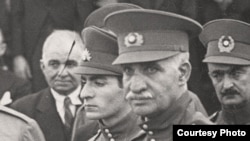Iranian security forces on April 6 arrested two Iranian political activists, Kamran Ayazi and Maryam Shariatmadari, near the site where a mummy believed to be Reza Shah Pahlavi’s body was unearthed on April 23, say incoming reports from Tehran.
Meanwhile, as the controversy about the whereabouts of the body continues in Iran and abroad, two Tehran city officials have said that the body has been re-buried somewhere close to where it was first located.
The Iranian Students News Agency (ISNA) quoted Hedayatollah Jamalipour the local governor of Shar-e Rey as saying that “unearthed bodies are buried in appropriate places.” However, he did not elaborate on the precise location of the body of the founder of the Pahlavi dynasty, the man who effectively modernized Iran in early 20th century and is respected by many Iranians as it was evidenced during massive demonstrations across Iran in January.
Tehran City Council member Mohammad Javad Haghshenas has also said based on “unconfirmed reports” that the mummy has been reburied.
Earlier Rouzarouz, the website that first broke the news of the mummy’s sighting, had quoted a local official as saying that the mummy has been put in a metal coffin and then buried in the same area near the holy shrine of Hazrat-e Abdolazim in southern Tehran.
Thousands of Iranians on social media have called for a respectful burial and a monument the monarch deserved. With Reza Shah allegedly "physically" back, tens of thousands of Iranian social media users are posting mostly sympathetic messages to the monarch who passed away in 1944 at the age of 66. "People called his name and he rose from ashes like phoenix", one Twitter user wrote in Persian on the day the mummy was found which was, perhaps ironically, one day before the anniversary of his coronation on April 24, 1926.
In his statement posted on April 24 on his official website, Reza Pahlavi, the grandson of Reza Shah has urged the Islamic Republic authorities to respect the exhumed body "if not as the father of modern Iran or a monarch" but at least "as a soldier and servant to the nation and the homeland".
"This is not only the concern of a person or a family, it is an issue with national and historic aspects. Reza Shah belongs to all people of Iran and his admirers", Prince Reza wrote.
He also called upon "all Iranians as the true guardians of [Reza Shah's] legacy" to assist the Pahlavi family through social media campaigns and peaceful rallies across the nation "to hold the government accountable and help lead this matter to a transparent and suitable conclusion".
Heeding to the prince’s call, Iranians on social media reminded the Iranian government what “Reza Shah the Great” did for the country. Iranian people and historians have characterized only four of Iranian monarchs, Cyrus the Great, Darius, and Shah Abbas as “great,” to pay tribute to their services.
Since then the prince has maintained silence and Radio Farda's attempts to speak to him have not been successful.
Professor Mohsen Ranani, a well-known economist, commented that “Reza Shah is not only part of Iran’s history, but he is also a symbolic asset that can attract tourists to Iran in the future,” ISNA quoted him as saying.
The controversy about the whereabouts of the mummy and its possible new burial place appears to have been fueled by concerns about a probable public action to show support for monarchy.
In the meantime, as massive riot police presence has been reported around the site where the mummy was unearthed, police has arrested at least two activists.
Iranian Human Rights News Agency reported on April 25 that the police have arrested Kamran Ayazi, a medical doctor and a former political prisoner at the site.
The Twitter account of the Campaign for Human Rights in Iran later reported the arrest of Maryam Shariatmadari at the site. She had been in jail previously for publicly protesting compulsory hijab.
On April 23, the head of the Tehran council's cultural heritage and tourism committee, Hassan Khalilabadi, was quoted by government news agency IRNA, conceding that it was "possible" the gauze-wrapped body found at the site belonged to Reza Shah Pahlavi.
"Some believe it is possible that the body belongs to the first Pahlavi that was transferred to Tehran after being mummified and buried in the shrine of Abdol Azim," he said on April 23.
But the head of the public-relations office of the shrine was quoted by local media as dismissing the reports about the body as "rumors" created on social media.
"The area surrounding the shrine was previously a cemetery, so discovering a body in this area is natural," the semiofficial ISNA news agency quoted Mostafa Ajorlou as saying.






